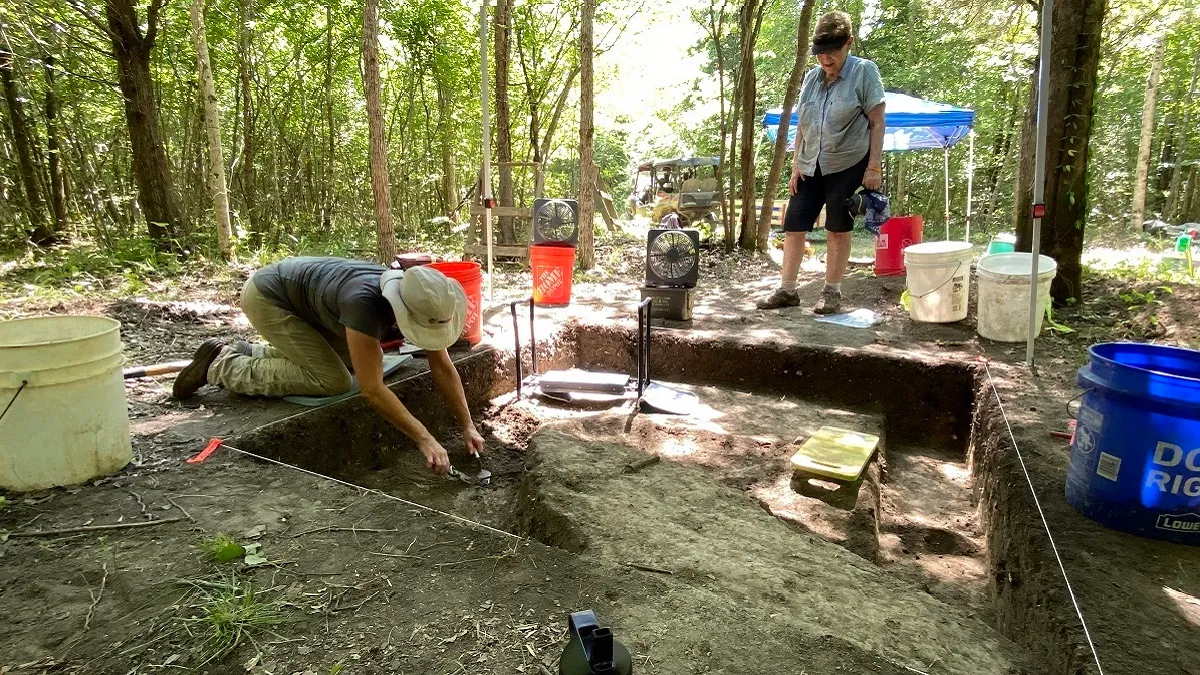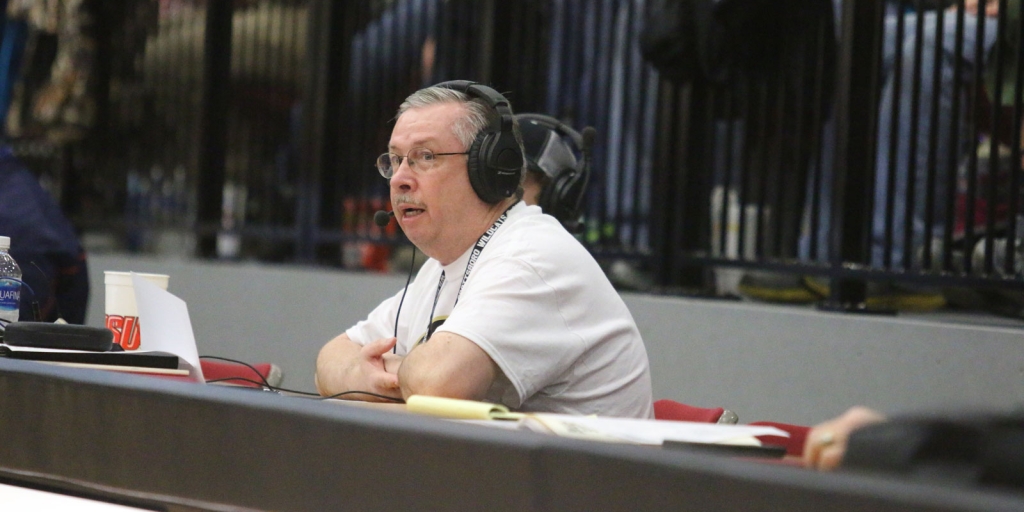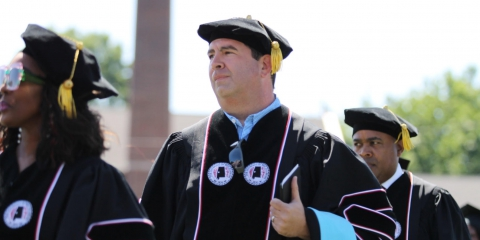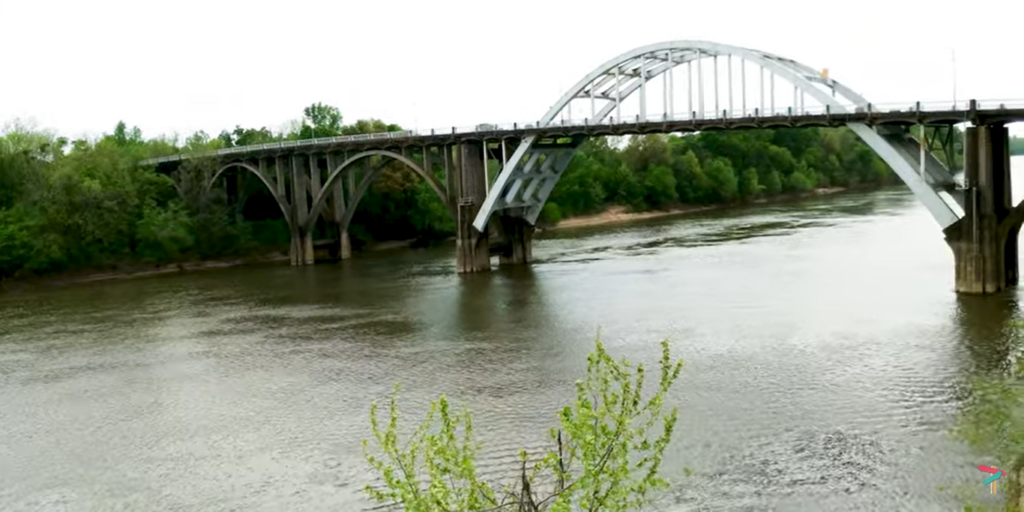On a blustery and blessedly cloudy June day, a team of archaeology experts and student volunteers from the University of West Alabama (UWA) carefully pick through soil in a Marengo County field that is ready for planting.
To the unskilled eye, the land looks no different than hundreds of other farm plots in this area of Alabama’s Black Belt. But sifting through the dirt, team leader Ashley Dumas has no difficulty pointing out the difference.
Scattered among the dusty clods are tiny fragments of pottery and fired clay – lots of it. They are the remnants of a community of native people who occupied this land around the mid-1500s.
Experts closing in on site of historic Battle of Mabila from Alabama NewsCenter on Vimeo.
Those indigenous families were no doubt surprised when an army of Spaniards, led by the notorious conquistador Hernando de Soto, passed by their modest farms. For one, the Spaniards would have been riding horses, which the locals would have never seen before. Spanish soldiers would also have been sporting metal breast shields and helmets and brandishing metal swords and tools – items completely foreign to the natives. At that time, the people who occupied what centuries later became the state of Alabama had no ability to forge metal.
On this day in 2022, however, metal tools are very much in the mix as Dumas and her teammates methodically dig rectangular trenches through the topsoil, searching for evidence of an event that changed the course of history.
It’s possible that, near this farm field, is the spot where a fortified native town called Mabila once stood. There, on Oct. 18, 1540, an epic and bloody encounter took place between thousands of native warriors, led by Chief Tascalusa, and a smaller but better-equipped force led by de Soto.
As many as 6,000 people, mostly natives, perished in the fight and the torching of the town by the Spanish in what is believed to be the single-largest battle ever fought between Europeans and the indigenous people of North America.
For more than a century, experts have been searching for Mabila. Now, supported by a growing collection of artifacts, the UWA team is convinced it is within a few miles of finding the precise site of the town and infamous battle. At the same time, the work is upending what many experts thought they knew about the lives and culture of the natives who clashed with de Soto and his men.
Since 2019, Dumas, an associate professor of anthropology at UWA, and her team have identified nearly 160 small native dwelling sites in Hale, Marengo and Perry counties. The work supports evolving scholarship that suggests the native people of the mid-1500s had shifted away from traditional river settlements and were living in scattered communities across the drier west Alabama prairie.
“It’s a totally new settlement pattern,” said Dumas, whose team has uncovered Spanish artifacts at a number of these settlements – evidence that de Soto’s army passed through the area.
The discoveries mean that for more than 100 years, the people who’ve searched in vain for Mabila likely were looking in all the wrong places. For decades, scholars presumed the town was somewhere along the Alabama or Tombigbee rivers. The Alabama Power Foundation has helped support some of the research. Now, because of the pioneering work of Dumas, retired University of Alabama anthropologist Jim Knight and partners from the University of Florida and the University of South Carolina, the search has shifted to higher ground between the two river basins.
A land rich in historic artifacts
A year ago, Dumas, Knight and the rest of the team began a careful dig just a few days before farmers planned to put in their spring crop. When the tractor arrived, the team had to put its archaeological work on pause – until this spring.
Last month, the team was able to return to the site and to two others in the vicinity where work had to be suspended last year.
On this day, the archaeological work is focused around two pits that the indigenous people created more than 400 years ago. To make the pits, the natives had to punch through a layer of hard chalk to reach water and mud, which they used to plaster the walls of their woven cane homes. Over the centuries, these pits became inadvertent repositories for all kinds of stuff, including precious cultural artifacts that washed into them during countless rains and windstorms.
“I imagine there were several houses here,” Dumas explains, looking out across the field. She said radiocarbon testing on some of the organic material found in this field, such as burnt seeds and wood, confirm they date from the middle of the 16th century.
Indeed, by June 24, the final day of spring digs at all three sites, the team had found some extraordinary native artifacts, Knight said, including a cup made of marine shell, a marine shell pendant and possibly the components of a necklace made from canine teeth – all likely dating to the mid-1500s.
As for the search for evidence of Europeans passing through here, metal-detecting at the sites explored in June resulted in recovery of nearly two dozen fragments of Spanish metal. In all, the team has uncovered more than 70 pieces of Spanish metal at eight sites over the past three seasons. They include horseshoes, pieces of barrel straps (which natives used as digging and scraping tools), even brass candlesticks. Over the three seasons, more Spanish artifacts have been recovered than had been found in decades of prior digs across the state.
Knight – editor of scholarly articles about the search for Mabila, published by the University of Alabama Press – said the finds “continue to amaze and confuse us.”
What’s amazing, Knight said, is the sheer volume of Spanish artifacts being uncovered so quickly – especially since the vast majority of the 160 identified native sites have yet to undergo metal-detecting.
It’s also confusing, he said, because without more study and exploration, the team can’t say for sure how all this Spanish metal got to where it is. Was it left here by the Spanish, or carried here later from some other place by the natives? Determining more precisely a pattern behind the finds, he said, could be key to ultimately identifying the exact route taken by de Soto and his men, which in turn could help lead the team to Mabila.
“Once we know the distribution of the farmsteads and draw a ring around that, Mabila should be right at the center,” Knight said, adding, “We’ve been focused so much on the distribution of farmsteads and relics, at the expense of the holy grail.”
Knight said it’s also not clear yet the exact time when these native farmsteads were settled. Was it immediately after the battle of Mabila – with the conflict driving the local people to spread out from the burned town – or was it decades later?

So close
Meanwhile, there’s a nagging feeling among team members that the few sites they’ve been able to closely examine could be literally walking distance from the long-sought site of Mabila. At the moment, however, the team has no way of knowing.
Dumas pointed to a field just a few hundred yards to the east, which the team has yet to receive permission to explore. It’s possible, she said, that it could be the battle site. Turning in the other direction, there’s a patch of land, partly covered in trees; it, too, could be the place where the ruins of Mabila lay just below the surface.
“I really believe we are very close,” said Dumas, who expresses gratitude for the landowners who’ve given permission for their properties to be explored. Of course, there are other landowners who are not so keen about opening their land to the archaeologists. Hopefully, that reluctance by some doesn’t become a hindrance to finally locating one of the most important sites in North American history.
Despite the challenges, “we remain excited and sort of awestruck at what we have found,” Dumas said a few days after the final day of digging. She noted that her hands – and back – were still sore from the hard labor, which took place during some of the hottest days recorded in Alabama in years.
She said last year’s work was all about getting a better handle on where the native farmsteads were located. This year, the effort focused more on gaining a clearer picture “of who these people are.” She said much of that knowledge is still to be “teased out” of the recovered artifacts over the next few months at UWA’s archaeology lab. There, hundreds of items will be cleaned, catalogued and closely examined. She anticipates that research will reveal patterns that can help the team more precisely identify when and how these natives lived and the circumstances that drove them to settle in the area. Some of the artifacts will be shared with expert colleagues in Florida and elsewhere, for their insights.
Through that work, during which Dumas says they will apply “all the tools of archeology and thought,” she hopes the team can soon make a “very calculated guess” about the best spots to search for signs of the elusive town of Mabila.
“We feel a growing confidence in our ability to find the battle site,” Dumas said.
Perhaps next year’s digging season will be the one that puts this centuries-old mystery to rest.
(Courtesy of Alabama NewsCenter)

























